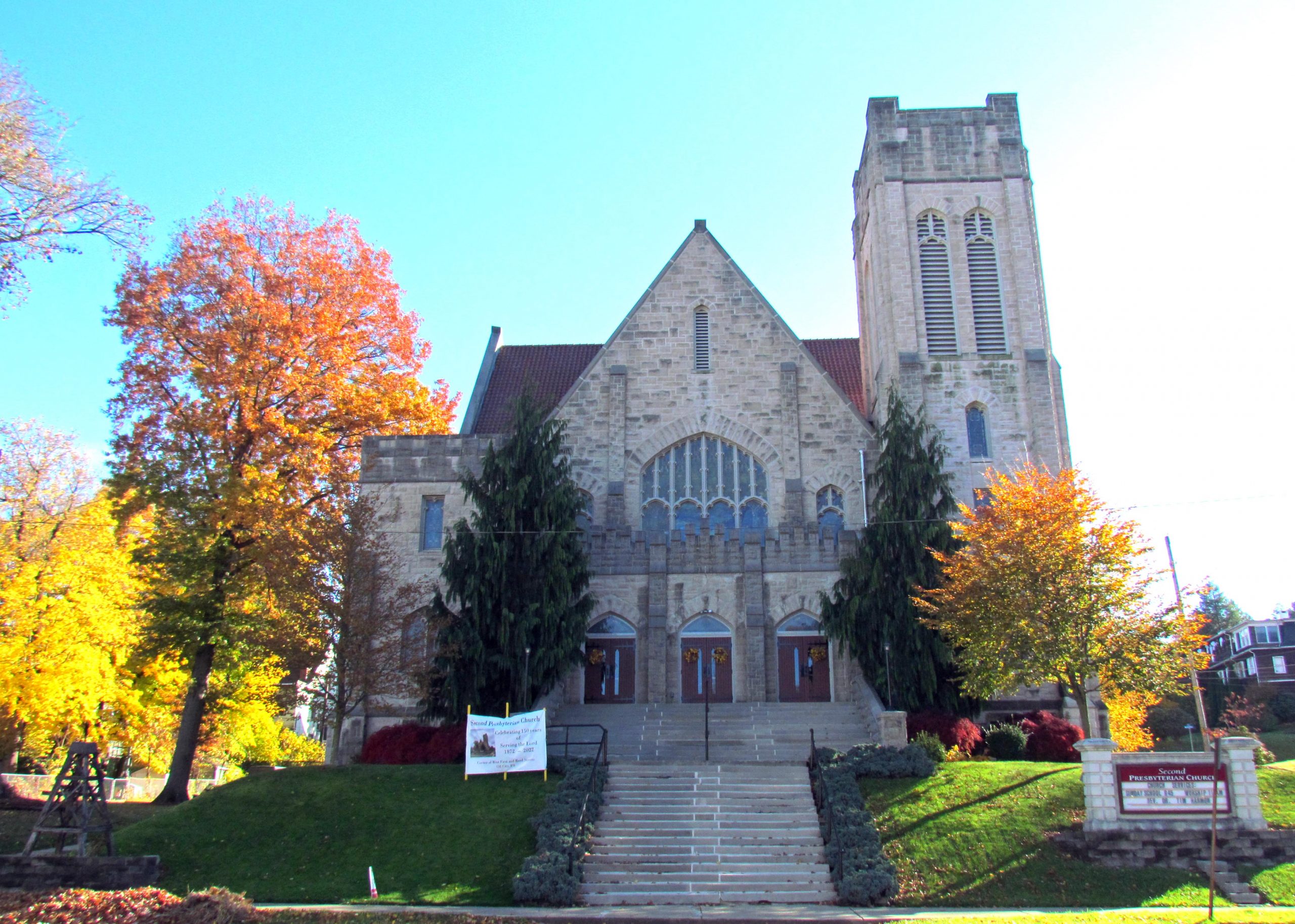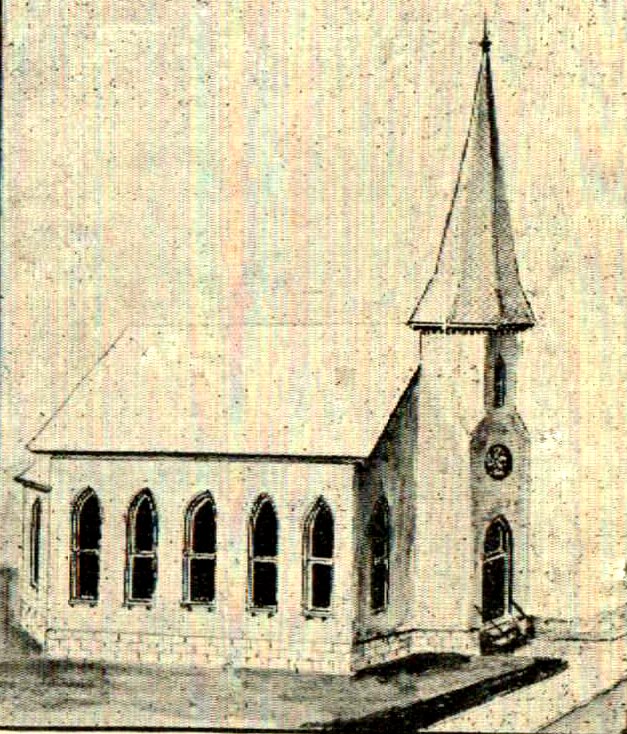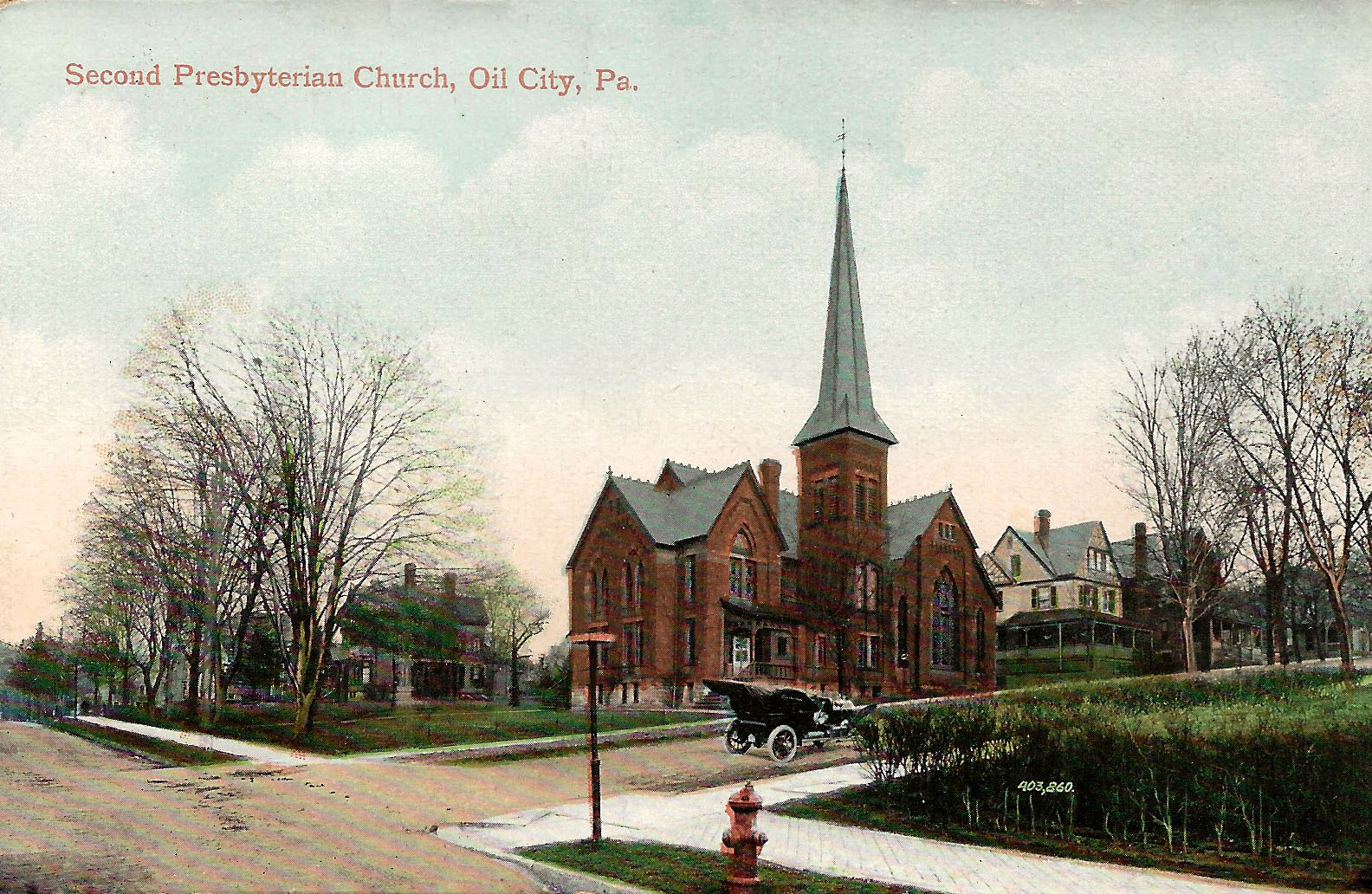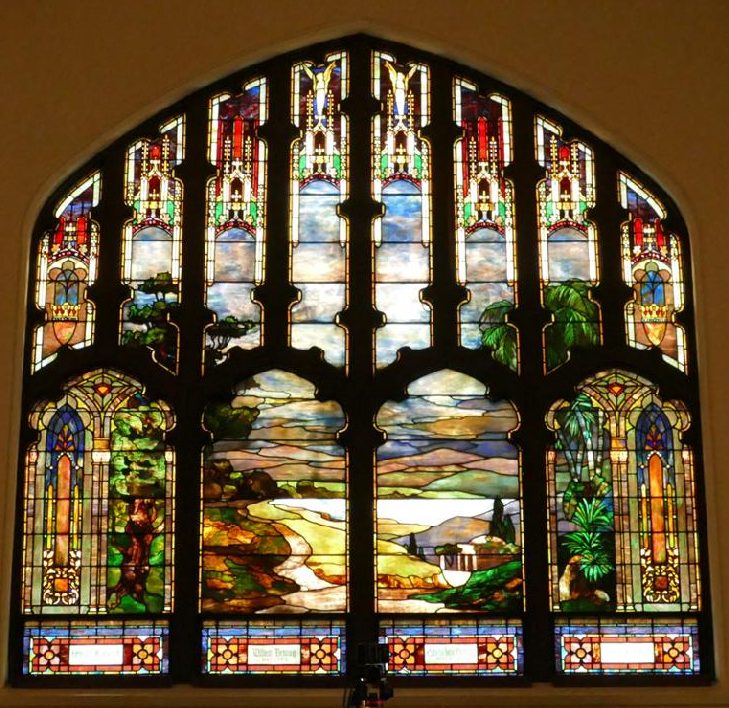Second Presbyterian Church
- Judy Etzel
- November 11, 2022
- Hidden Heritage
- 9618
A Milestone in 2022
Second Presbyterian Church, one of Oil City’s most imposing churches, marked its 150th anniversary in 2022.
Organized on Jan. 13, 1866, with 29 charter members, church members met in a rented hall at the corner of Front Street and Central Avenue.
There was some discussion that the new church should merge with the First Presbyterian Church that was organized five years earlier. However, that effort stalled and the struggling congregation voted to disband.
However, the rapid development of the South Side neighborhoods due to the growth of the fledgling city revived the idea of a separate church. In 1870, Capt. John Munhall and several other individuals purchased a vacant lot at the corner of Reed and West First Streets.
They made plans to build a church and raised $8,100 for a wooden building and all furnishings.
On Aug. 5, 1872, the 56 members of the new Second Presbyterian Church legally incorporated and one year later held dedication services at the new church building. According to church records, “ladies of the church” procured all the furniture, with the exception of the pulpit, and paid for the landscaping as well as picking up the tab to pay the salaries for the sexton and organist. Rev. David T. Carnahan was the first pastor of the church, which by then boasted a membership of 233 people.
New Building is Needed
Church and Sunday School membership continued to grow and, under the direction of Rev. Wilbur Wood who replaced Carnahan in 1882, the decision was made to build a new church structure. A brick building was constructed at the same site at a cost of $28,000. It was dedicated in June 1884.
Money woes, though, soon began to plague the congregation with church leaders reporting that weekly income was $18 but expenses were $60-plus in mid-1885. Even the minister was not being paid. Over a period of several months, the congregation pitched in enough to correct the finances.
In that time period, the Second Presbyterian Church acquired a signature piece of liturgical equipment – an elegant organ. H.L. Foster, a church member, purchased the organ, which had won first prize for its exquisite tones at the 1876 Philadelphia Centennial, and installed it in his South Side home. In April 1889, he offered it to the church for $2,500 and it was dismantled and installed in the sanctuary. It remains part of a larger organ set-up in the church.
Membership Surge Continues
Once again, the congregation outgrew the church erected in 1884 and a new building was constructed in 1914. The $93,000 stone church was dedicated on Jan. 3, 1915, and continues to be the home of Second Presbyterian Church.
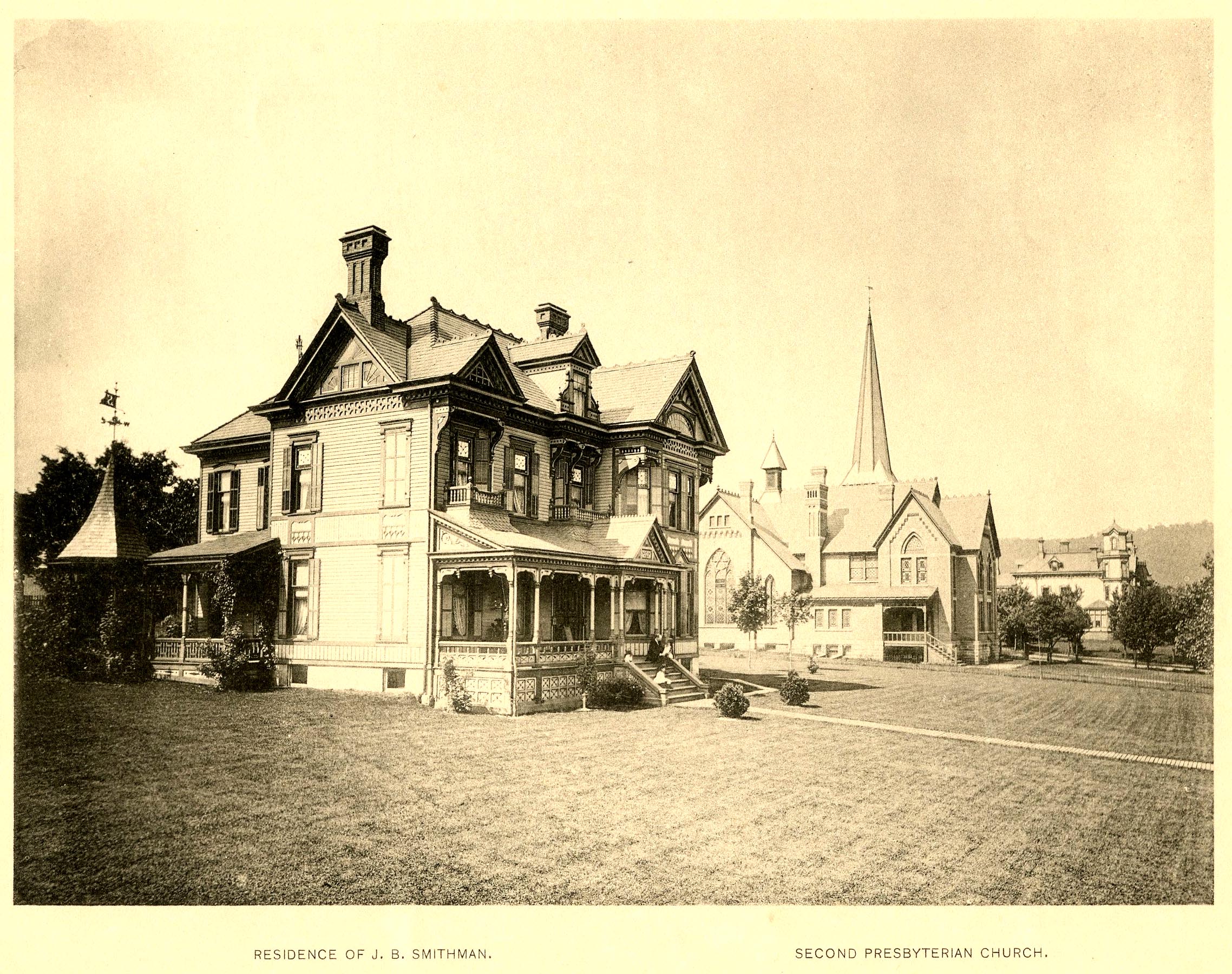
The project was done while Rev. S.A. Cornelius, who would serve the longest tenure at Second Presbyterian at 24 years, was pastor. His oversight also included the construction of a manse adjacent to the church.
A decade after the third church was built, church membership numbered 722 resident members and 85 non-resident members.
The Second Presbyterian Church agenda was full and offered Sunday School, Bible classes, Ladies Aid Society, Women’s Missionary Societies, Light Bearers, Christian Endeavor Society, Vacation Bible School and much more.
Boy Scout troops and Girl Scout Troops, with the latter being the first local troop to be established, soon joined the list of church organizations.
Church Programs Expanded
In the 1930s and 1940s, there were several changes instituted at the church by the pastor, Rev. Arthur McCormick. Monday evening poetry sessions were scheduled and an annual lecture series featuring renowned speakers was set up. A children’s choir and a Sunday School orchestra were organized. The pastor initiated a children’s sermon and arranged to have the Sunday worship service broadcast live over local radio.
The Women’s Missionary Group, comprised of eight circles named after women of the Bible, flourished. Church membership was about 900.
Rev. Mason Cochran assumed the pulpit in 1950 and he organized a Mr. and Mrs. Club to help new members become acquainted, led weekly Junior and Senior High Fellowship groups, developed a scholarship fund and switched what had been a Wednesday night prayer meeting to a weekly church night supper.
In his tenure, church members elected their first women deacons (Dorothea Clark and Jean Townsend) and first women trustees (Maude Gnade and Carlotta Berry). The church also changed up its musical routine, replacing a paid quartet with a volunteer adult choir led by Gerald Keefer.
Rev. Robert B. Shane was named pastor in 1958. In his first year, Nell and Mable Gleave presented the church with 25 English White Chapel handbells. A bell choir, comprised of high school boys, was organized under the direction of musician Major “Maj” D. Olmes Sr. The helm was taken over a few years later by Harold Adams.
Extensive interior renovations were done, in 1963 and 1964 with the church congregation raising $300,000 to pay for the work. A new program was launched that consisted of volunteer nurses and church members, including June Kennedy, Lois Carothers, Lois Logan, and Kay Felmlee, who would care for children during Sunday worship.
The congregation elected Rebecca Skinner as the first woman elder in 1964.
Ministerial Changes
Harold Kelley was selected as pastor and he served from 1971 to 1982. He started a popular Friday morning men’s prayer breakfast and was key in forming Youth Alternatives as an agency to help young people in the community. He also oversaw the church’s sponsorship of two Vietnamese refugees, a young couple that made Oil City their new home.
Brian Thomas was hired as choir director and he would serve for 25 years. Joining him in the music department was Norma Kelly who served as church organist for more than 30 years. Rev. Roger G. Wagner was named pastor in 1983 and he was joined five years later by Michael Jones who was hired as the church’s first associate pastor.
After a series of interim pastors, Dr. Howard Gaston was chosen as full time pastor and served from 2002 to 2010. Church secretary Linda Solinger retired in 2005 after 37 years of service. In 2010, South Africa native Dr. Johannes “Jannie” Swart assumed the title of pastor and established the church’s Open Door Café.
Rev. Greg Gillispie served from 2014 to 2017 with Rev. Sue Montgomery filling in as a temporary supply pastor until 2019.
An ‘Intentional’ Mission
The current minister, Rev. Dr. Tim Harmon, was hired in 2019 after serving churches in South Dakota and Iowa. He has been a college instructor and previously worked as a school psychologist.
He joined Josh Botts, a longtime church member who was commissioned as pastor of Community Mission to offer leadership to the church as well as the full community.
In a newspaper review in 1994 about local Oil City churches, the Second Presbyterian congregation was asked what was unique about their church. The answer was: “Our church has been very intentional about involving itself in all the affairs of the community, including spiritual, social, economic and political.”
Second Presbyterian Windows
Second Presbyterian Church is blessed with dozens of stained glass windows that are testimony to the largesse of the church members and the memory of those individuals to whom the windows were dedicated.
The towering windows in the sanctuary were designed and manufactured by the Rudy Brothers of Pittsburgh. The Rudy siblings’ first work was done in 1893 in Pittsburgh for H.J. Heinz who had the ornate windows installed in his factory and his home.
The stone Second Presbyterian Church as well as its ornate windows speak to the immense wealth and keen cultural appreciation of Oil City’s early citizens. At the close of the Civil War and only a couple years after the petroleum industry was launched at Titusville, a huge wave of veterans as well as European immigrants set out for western Pennsylvania to make their fortunes in the oil field.
Their successes led to immense wealth, civic engagement, community pride, philanthropy and cultural pursuits – all of it dramatically enhanced Oil City. The effects, too, were felt by the community’s institutions, including Second Presbyterian Church.
The Chambers Window
The Chambers Window is in the church sanctuary. It is dedicated to Bertha Chambers who was married to Fred Chambers. They lived at 204 West First Street. The two met as a result of a bobsled accident in 1878. Bertha, Fred and friends were bobsledding down Petroleum Street as teenagers when their sled hit a tree. Bertha was seriously injured but recovered. She ended up marrying Fred, who would go on to found a large hardware store on Center Street. His building boasted its own electric plant in the basement so he could light up his display windows.
The Fleming Window
The Fleming Window, located in the church balcony, is dedicated to William Fleming and was given by his family. William Fleming, a Civil War veteran, came to Oil City in 1865 and formed a partnership with J.E. Cribbs in the sale of flour and feed on the South Side. He married Ophelia Jane Ray and they lived at 310 Central Ave. Fleming then entered the oil business and became associated with the Standard Oil Co. He was named vice president and general manager of the Ohio Oil Company. He and his wife, Ophelia, had four children. Maude, a Wellesley College graduate, married Edward Gnade who was manager of Oil Well Supply. Walter became president of Marathon Oil Co. Grace married George Relf and was a founder of the Winifred Tonkin Guild of Oil City. Margaret married Alfred Landon of Kansas who would go on to seek the presidency of the U.S.
The Snowden Window
The Snowden Window, located in the church sanctuary, is dedicated to James M. and Mary Ann Snowden who lived on Orange Street. After trying his hand in the oil business, James later set up a cracker and candy company in Pittsburgh. Returning to Oil City, he served as coroner during the Great Fire and Flood of 1892 in the Oil Valley and presided over the temporary hospital set up for the injured at Christ Episcopal Church. Accounts note that he spent his days and nights attempting to identify the more than 40 men, women and children from the Oil City area who had died from the fire or water.
Written by Judy Etzel with research by Kay Dawson and design by Natalie Cubbon.
HIDDEN HERITAGE IS SPONSORED BY:
Jack Eckert & Susan Hahn
— In Memory of Kay Ensle —
Support This Project
Donations to the library are appreciated to help offset printing costs & make this project possible! Want to become a sponsor? Email us at promotions@oilregionlibraries.org to get started!
Make a Donation
